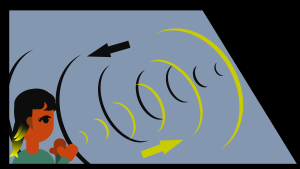Hearing in Complex Environments
65
Learning Objectives
Understand how echo can help us determine the layout of our environment.
Be able to define the reverberation time.
An echo is the reflection of sound from its original source. When you clap in a hallway, the clap you hear after is the echo. It works similarly to sound localization that would be used to locate a plane in the air. But instead of experiencing the direct interaction between the sound’s source and our ears, we utilize the reflection of the sound against surrounding materials and the delay this causes for the sound to reach us.

Echo also helps to determine the relative size of a space and the compositions of the materials within it. This perception is a result of reverberation time: the time it takes for a sound to decay 60 decibels from its original loudness. This is usually measured in terms of amplitude. Different materials can extend reverberation (ex. hardwood, metal) or muffle it (ex. foam, carpet) by absorbing more or less of the sound.
The sensation of echo and use of reverberation can be combined with monaural and binaural cues to create a more complex experiences of our surroundings through detailing sensory information, like hearing a myriad of musical notes in a concert that aren’t actually being played individually.

(Provided by: OpenStax. License: CC-BY 4.0.)
Exercises
- What does an echo help determine?
A. Relative sound of a space
B. Relative size of a space
C. Relative shadow of a space
D. Relative location of a spaceCorrect answer: B) relative size of a space
Cheryl Olman PSY 3031 Detailed Outline
Provided by: University of Minnesota
Download for free at http://vision.psych.umn.edu/users/caolman/courses/PSY3031/
License of original source: CC Attribution 4.0
Adapted by: Jarod DavisWikipedia, Echo
URL: https://en.wikipedia.org/wiki/Echo
License: CC BY SA 4.0
Adapted by: Jarod Davis

